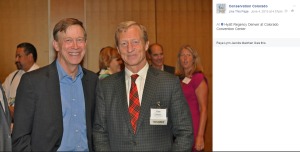Less than a year ago, Colorado’s environmental and Democratic establishment gathered in downtown Denver to honor one of their champions: San Francisco billionaire and climate activist Tom Steyer.
The awards dinner, hosted by Conservation Colorado, followed a $74 million campaign by Steyer to elect Democrats in 2014. From that total, roughly $8.5 million was spent in a failed effort to save former U.S. Sen. Mark Udall (D).
At a reception before the June 2015 dinner, Gov. John Hickenlooper (D) paid tribute to Steyer, calling the California billionaire “a remarkable leader in this country,” according to the Denver Post. “Tom Steyer has done as much as any individual to focus this country’s environmental movement and make sure people are getting information and that people have the capacity to organize,” Hickenlooper said.
Today, however, the governor’s tributes are less than enthusiastic.
“[Tom Steyer] invests a lot in Colorado elections on behalf of Democrats. Is his involvement here a good or a bad thing for Democrats?” CBS4 political specialist Shaun Boyd asked Hickenlooper last week during a panel discussion with the governor and Jack Gerard, the president and CEO of the American Petroleum Institute.
“I think Jack could probably answer that better than I could,” Hickenlooper quipped, drawing laughter from the audience of state lawmakers, local officials and business leaders. “You know, I think that outside money coming into states is always difficult, and both parties have become dependent on it, to a large extent,” the governor continued. “I don’t think in this case that it’s gone over the top yet.”
So, in the eyes of Colorado’s Democratic governor, Steyer has gone from “remarkable leader” to “outside money” in less than a year. To be sure, Hickenlooper didn’t demand a stop to Steyer’s spending, but the California billionaire’s involvement in Colorado politics is clearly an uncomfortable subject.
That’s not all. During the same panel discussion, Hickenlooper also sought to minimize the role of anti-fossil fuel activists in Democratic Party politics. It was a striking move, because of Hickenlooper’s past observations about his party’s environmental wing.
While running for reelection in 2014, Hickenlooper cited his support for oil and natural gas development as an example of where he’s gone against the Democratic Party. “Many in my party feel that hydraulic fracturing or any kind of hydrocarbon extraction is dangerous and should be banned,” Hickenlooper said at the time. It was a prophetic statement. Just over a month ago, Bernie Sanders trounced Hillary Clinton in the state’s Democratic caucuses with a campaign that included TV ads touting his opposition to fossil fuels.
But during last week’s panel, Hickenlooper tried to explain it all away. Yes, those who attended the Democratic caucuses were “very fired up,” he said. “But it’s not an accurate representation of the people of Colorado,” he quickly added. “If you’re looking at how many people in Colorado who really want to get off hydrocarbons, and just ban all hydrocarbons, it’s probably a fairly small minority.”
Remarkable. The state’s top Democrat would rather call the base of his own party unrepresentative than draw attention to the rising influence of anti-fossil fuel activists on the left. Why go to such lengths to convince the public – and especially the press – that there’s nothing to see here?
Maybe it’s because Democratic leaders don’t want the public to know about the battle raging between the blue-collar wing of the party and far-left environmental forces. Environmental donors like Steyer and environmental groups like 350.org and Food & Water Watch have grown tired of playing second-fiddle to other Democratic constituencies, especially organized labor. They want to run the show and they are making their move. It’s one of the biggest reasons for the persistence of the Sanders campaign the much harder line Clinton has been taking against the fossil fuels that power more than 80 percent of the U.S. economy.
It’s a divisive and damaging debate for Democrats because it directly impacts the household budgets of working families. Through a combination of mandates, subsidies, tax increases and punitive laws, big environmental groups and their donors want to eliminate the affordable energy sources we have today and force the nation into using much more expensive alternatives. And as these groups and donors become more aggressive in pushing their agenda, the conflict between Democrats is spilling into public view.
There are examples everywhere if you know where to look. Two state House Democrats sided with Republicans this week to defeat a “local control” bill targeting the oil and gas industry. Hickenlooper’s chief strategist got into a heated social-media exchange with another House Democrat over the subject of fracking.
The governor himself has called an oil and gas bill from the same Democratic lawmaker “anti-business,” and warned anti-fracking ballot measures pushed by environmental groups could cost the state “many billions of dollars.” Meanwhile, Steyer’s political action committee – NextGen Climate – says it won’t support U.S. Sen. Michael Bennet (D) until he renounces his past support for the Keystone XL pipeline.
Nevertheless, Hickenlooper and senior Democrats are trying to downplay the conflict over energy inside their party as much as they can – and for good reason. The more attention it gets, the more the public will hear about California billionaires, fringe environmental groups, their influence over Democratic politics in our state, and how much their plans will cost Colorado’s families and businesses. That’s an awkward conversation to be having with voters during an election year, to say the very least. So why not just avoid it altogether?
Simon Lomax is an associate energy policy analyst with the Independence Institute and a consultant who advises pro-business groups. From 2004 to 2012, he was a news reporter covering energy and environmental policy in Washington, D.C. Contact him at simon@i2i.org.



